As we reflect on the 2024 presidential election, one thing is clear: voter engagement matters more than ever. In last fall’s election we witnessed surprisingly high voter turnout, challenging the conventional wisdom that high turnout typically benefits one political party over another. While much of the focus has been on the outcome itself, it’s crucial to recognize that the 2024 election provided important lessons about voter participation, demographic shifts, and the need for effective engagement.
In Georgia, Nevada, and Wisconsin—three pivotal battleground states—voter turnout reached historic levels, mirroring the participation seen in the 2020 presidential election. These states highlighted the significance of engaging voters across all demographics, proving that high participation isn’t the exclusive advantage of any single party. However, how voters are engaged and the messages they receive during an election cycle are just as important as the act of voting itself.
Demographic Shifts and Their Implications
Exit poll data from ABC News revealed notable changes in voter preferences, particularly among demographic groups that shifted their support for Donald Trump between 2020 and 2024. These trends varied across Georgia, Nevada, and Wisconsin, offering valuable insights for future voter engagement efforts:
Georgia: Record-Breaking Turnout
With 5.29 million voters casting ballots in 2024, Georgia surpassed its previous high from 2020. A look at the exit polls reveals some striking shifts. Support for Donald Trump increased significantly among key demographic groups. Latino women in Georgia showed an 8% uptick in support for Trump, and “all other races” saw a 17% increase.
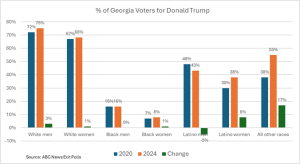
Nevada: The Power of Growing Diversity
Nevada also experienced a notable increase in voter turnout, with 1.5 million ballots cast in 2024—surpassing the 2020 total. Similar to other swing-states, in Nevada, support for Trump grew across multiple groups, with Latino men and women showing a 17% and 14% increase, respectively.
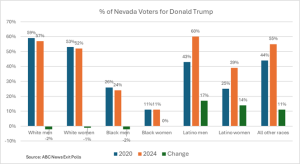
Additionally, non-white voters with and without college degrees both shifted their support towards Trump by significant margins.
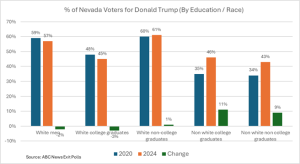
Wisconsin: Surprising Shifts Among Age Groups
In Wisconsin, nearly 3.4 million voters cast ballots, surpassing the 3.3 million who participated in 2020. The biggest shifts in support for Trump came from younger voters (18-29 year-olds) and non-white, non-college graduates, who showed increases of 12% and 9%, respectively. However, older voters (65 and over) showed a 12% decline in support for Trump, demonstrating that voter engagement isn’t a one-size-fits-all approach.
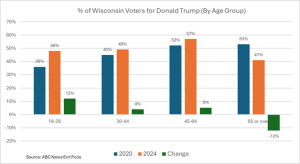
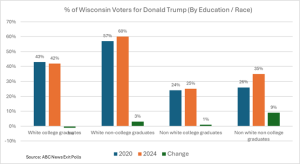
Lessons for Future Engagement
These shifts demonstrate that high voter turnout is not inherently advantageous to one party over another. Instead, the impact of turnout depends on how voters are engaged and mobilized. In Georgia and Nevada, for instance, concerns about inflation and job security, and dissatisfaction with the Biden administration’s handling of the economy, fueled the major demographic shifts. In Georgia, Nevada, and Wisconsin, the data also suggests that targeted outreach to different communities and demographic groups played a pivotal role in shaping outcomes, highlighting the importance of listening to voters, addressing their specific needs, and fostering a sense of empowerment and inclusion.
It’s also important to recognize that the outcome of the 2024 election was shaped by other critical factors. Other influential elements included missteps from the Democratic party, such as President Biden’s delayed exit from the race followed by Vice President Harris’ historically short 107-day campaign and a focus on cultural issues over economic concerns (which drove a wedge between the party and working-class voters), the growing influence of alternative media platforms and the spread of misinformation. The prevalence of misinformation and shifting media landscapes contributed to voter confusion and uncertainty. As an organization deeply committed to strengthening our democracy, OneV looks forward to further analyzing the boarder and complicated picture surrounding the 2024 election. Nonetheless, a good starting point is focusing on voter participation and direct voter engagement – two of the most important ingredients of any healthy democratic system.
Moving Forward Together
As we prepare for another transfer of power on January 20, we encourage all Americans to remain engaged in the political process. Democracy thrives when citizens exercise their voting rights, participate in meaningful dialogue, and hold leaders accountable. High turnout is a testament to the enduring strength of democracy, but it also reminds of the responsibility we all share in sustaining it.
At OneV, we believe that a vibrant democracy depends on participation from everyone, regardless of political affiliation. The 2024 election demonstrated that voter turnout alone does not determine outcomes—how we engage voters is equally critical. As we look to the future, let’s recommit to ensuring that every voice is heard, every vote is counted, and every American is invested in the democratic process.
Join us in this mission. Visit www.OneV.vote to learn more about how you can support voting rights and civic engagement. Together, we can build a stronger, more inclusive democracy—one nation, every vote.